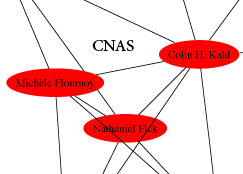The edit network for “telephone tapping” shows a bipartite structure, indicating that the topic is controversial (image from Brandes et al.)
An interesting new paper defines the “edit network” of a Wikipedia article by drawing edges to indicate that one person has deleted or restored text written by another. While it’s always fun to look at pictures, the surprise here is that we can verify that the resulting graph structure really does tell us something useful about the article. In this study, articles with a more “bipolar” edit network — meaning that the authors split into basically two camps who routinely undid each other’s edits — were also much more likely to appear on a manually-maintained list of controversial pages.
Although there has been previous work on network mapping of Wikipedia in particular (and of course volumes of work on social networks in general) I find this paper interesting because it tries very carefully to understand whether the pictures mean anything. Like all science, what you find depends on where you look, and the practitioner of network analysis has an absurd amount of freedom to define what a “node” is, what an “edge” is, and how the resulting graph is visually laid out (since the point of a map is a visual representation, it’s very important that graphical properties such as distance, size, color, etc. have the right sort of metaphorical relationships to the more abstract properties we are trying to understand.)
Continue reading What Can We Learn From the Network Structure of Wikipedia Authors?

